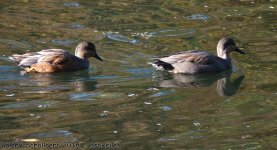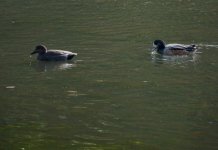-
Welcome to BirdForum, the internet's largest birding community with thousands of members from all over the world. The forums are dedicated to wild birds, birding, binoculars and equipment and all that goes with it.
Please register for an account to take part in the discussions in the forum, post your pictures in the gallery and more.
You are using an out of date browser. It may not display this or other websites correctly.
You should upgrade or use an alternative browser.
You should upgrade or use an alternative browser.
Brussels, Belgium : Red-flanked Gadwall ? (2 Viewers)
- Thread starter Valéry Schollaert
- Start date
More options
Who Replied?Birdbrain22
Well-known member
just a thought... intersex Gadwall?
https://birdingfrontiers.wordpress.com/2011/01/02/intersex-female-gadwall/
https://birdingfrontiers.wordpress.com/2011/01/02/intersex-female-gadwall/
Last edited:
BobbitWorm45
Well-known member
retarded moult form juvenile plumage??
Birdbrain22
Well-known member
retarded moult form juvenile plumage??
and that is the other option as the sometimes take most of winter to acquire adult male plumage. Perhaps we will need to watch and wait until then to know for sure.
Valéry Schollaert
Respect animals, don't eat or wear their body or s
Hybrid Wigeon-X-Gadwall?
That was my idea in the field, but comparing with photos online, I'm now less convinced, hence my need of help.
Valéry Schollaert
Respect animals, don't eat or wear their body or s
You may want to PM Joern Lehmhus... He's very much into duck hybrids
Thanks for suggestion, I sent him.
There's a male Chiloe Wigeon around...
Valéry Schollaert
Respect animals, don't eat or wear their body or s
Valéry Schollaert
Respect animals, don't eat or wear their body or s
I've seen Joern Lehmhus, may be can I have your opinion ?
Joern Lehmhus
Well-known member
Hi Valéry,
just seeing this and i would agree on "Intersex" -plumaged Gadwall. I have seen few other so far, but the reddish flanks seem to be typical.
Gadwall x Chiloe wigeon has somewhat similar flanks, but a bicolored bill and green head gloss as so many other Gadwall hybrids with fully or partly greenheaded dabbling duck species. Example here:
https://waarneming.nl/media/photo/001/086/1086955.jpg
just seeing this and i would agree on "Intersex" -plumaged Gadwall. I have seen few other so far, but the reddish flanks seem to be typical.
Gadwall x Chiloe wigeon has somewhat similar flanks, but a bicolored bill and green head gloss as so many other Gadwall hybrids with fully or partly greenheaded dabbling duck species. Example here:
https://waarneming.nl/media/photo/001/086/1086955.jpg
Valéry Schollaert
Respect animals, don't eat or wear their body or s
Hi Valéry,
just seeing this and i would agree on "Intersex" -plumaged Gadwall. I have seen few other so far, but the reddish flanks seem to be typical.
Gadwall x Chiloe wigeon has somewhat similar flanks, but a bicolored bill and green head gloss as so many other Gadwall hybrids with fully or partly greenheaded dabbling duck species. Example here:
https://waarneming.nl/media/photo/001/086/1086955.jpg
I see, also I've not yet fully understood "Intersex" meaning, do you have any link explaining properly ?
Many thanks !
Joern Lehmhus
Well-known member
concerning intersex, I think the original medical term refers to a person or an animal having partly both maye and female primary sexual characteristics- but I am far from sure if this is fully correct.
but in many Intersex plumaged birds it is so that only the plumage is changed. so these would not be true intersexes. Very often it is female birds where the female plumage changes to male plumage characteristics (or sometimes some strange in-betwee n characteristcs that ar enot expressed by either sex.) In German this is called hahnenfedrig (meaning cock -feathered).
The reason in short seems to be:
In many birds with different male and female plumages the male plumage is the standard plumage, but that is in females suppressed by oestrogen content. If this oestrogen level is reduced due to damaged or very old ovaries, a female bird starts to develop male plumage characteristics. This can go relatively far in some species and an intersex plumaged mallard for example can look nearly like a normal male.
this is for example such a case in Aix galericulata
https://www.kleindiermagazine.nl/KM...iles/assets/basic-html/page44_images/0011.jpg
this is a photograph from me from intersex pintail
http://4.bp.blogspot.com/-GWwhD15Uovk/VKmGgCgPG9I/AAAAAAAAETw/kX1DPAaROdc/s1600/1632.jpg
the wide barring in the flanks is something not seen in either sex , but it is very common in "intersex" plumaged pintails and Common /greenwinged teals
intersex mallards:
http://1.bp.blogspot.com/-WK4OhW6vhsE/VKl6AlHRiSI/AAAAAAAAETM/pqAC8fR--P8/s1600/1029.jpg
http://1.bp.blogspot.com/-5gwEWwpa6f0/VPHwXkZSQUI/AAAAAAAAFhU/CFxiMdmp79I/s1600/1829.jpg
but in many Intersex plumaged birds it is so that only the plumage is changed. so these would not be true intersexes. Very often it is female birds where the female plumage changes to male plumage characteristics (or sometimes some strange in-betwee n characteristcs that ar enot expressed by either sex.) In German this is called hahnenfedrig (meaning cock -feathered).
The reason in short seems to be:
In many birds with different male and female plumages the male plumage is the standard plumage, but that is in females suppressed by oestrogen content. If this oestrogen level is reduced due to damaged or very old ovaries, a female bird starts to develop male plumage characteristics. This can go relatively far in some species and an intersex plumaged mallard for example can look nearly like a normal male.
this is for example such a case in Aix galericulata
https://www.kleindiermagazine.nl/KM...iles/assets/basic-html/page44_images/0011.jpg
this is a photograph from me from intersex pintail
http://4.bp.blogspot.com/-GWwhD15Uovk/VKmGgCgPG9I/AAAAAAAAETw/kX1DPAaROdc/s1600/1632.jpg
the wide barring in the flanks is something not seen in either sex , but it is very common in "intersex" plumaged pintails and Common /greenwinged teals
intersex mallards:
http://1.bp.blogspot.com/-WK4OhW6vhsE/VKl6AlHRiSI/AAAAAAAAETM/pqAC8fR--P8/s1600/1029.jpg
http://1.bp.blogspot.com/-5gwEWwpa6f0/VPHwXkZSQUI/AAAAAAAAFhU/CFxiMdmp79I/s1600/1829.jpg
Last edited:
Valéry Schollaert
Respect animals, don't eat or wear their body or s
concerning intersex, I think the original medical term refers to a person or an animal having partly both maye and female primary sexual characteristics- but I am far from sure if this is fully correct.
but in many Intersex plumaged birds it is so that only the plumage is changed. so these would not be true intersexes. Very often it is female birds where the female plumage changes to male plumage characteristics (or sometimes some strange in-betwee n characteristcs that ar enot expressed by either sex.) In German this is called hahnenfedrig (meaning cock -feathered).
The reason in short seems to be:
In many birds with different male and female plumages the male plumage is the standard plumage, but that is in females suppressed by oestrogen content. If this oestrogen level is reduced due to damaged or very old ovaries, a female bird starts to develop male plumage characteristics. This can go relatively far in some species and an intersex plumaged mallard for example can look nearly like a normal male.
this is for example such a case in Aix galericulata
https://www.kleindiermagazine.nl/KM...iles/assets/basic-html/page44_images/0011.jpg
this is a photograph from me from intersex pintail
http://4.bp.blogspot.com/-GWwhD15Uovk/VKmGgCgPG9I/AAAAAAAAETw/kX1DPAaROdc/s1600/1632.jpg
the wide barring in the flanks is something not seen in either sex , but it is very common in "intersex" plumaged pintails and Common /greenwinged teals
intersex mallards:
http://1.bp.blogspot.com/-WK4OhW6vhsE/VKl6AlHRiSI/AAAAAAAAETM/pqAC8fR--P8/s1600/1029.jpg
http://1.bp.blogspot.com/-5gwEWwpa6f0/VPHwXkZSQUI/AAAAAAAAFhU/CFxiMdmp79I/s1600/1829.jpg
That's a very helpful answer, thanks for that B

Valéry, thanks for asking and Jörn thanks for answering the intersex question
Users who are viewing this thread
Total: 3 (members: 0, guests: 3)





